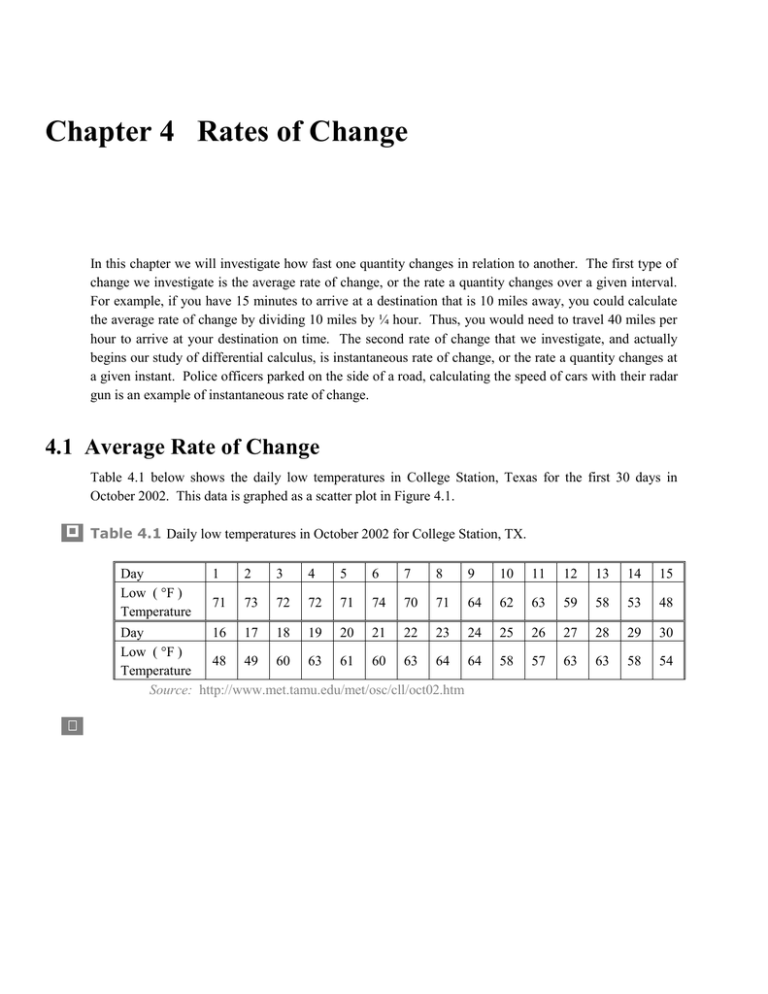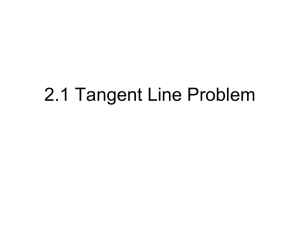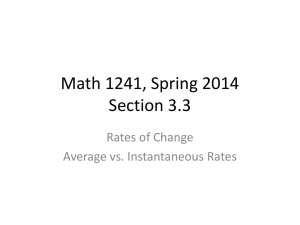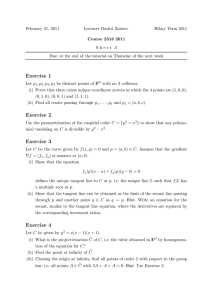Chapter 4 Rates of Change
advertisement

Chapter 4 Rates of Change In this chapter we will investigate how fast one quantity changes in relation to another. The first type of change we investigate is the average rate of change, or the rate a quantity changes over a given interval. For example, if you have 15 minutes to arrive at a destination that is 10 miles away, you could calculate the average rate of change by dividing 10 miles by ¼ hour. Thus, you would need to travel 40 miles per hour to arrive at your destination on time. The second rate of change that we investigate, and actually begins our study of differential calculus, is instantaneous rate of change, or the rate a quantity changes at a given instant. Police officers parked on the side of a road, calculating the speed of cars with their radar gun is an example of instantaneous rate of change. 4.1 Average Rate of Change Table 4.1 below shows the daily low temperatures in College Station, Texas for the first 30 days in October 2002. This data is graphed as a scatter plot in Figure 4.1. Table 4.1 Daily low temperatures in October 2002 for College Station, TX. Day Low ( F ) Temperature 1 2 3 4 5 6 7 8 9 10 11 12 13 14 15 71 73 72 72 71 74 70 71 64 62 63 59 58 53 48 Day 16 17 18 19 20 21 22 23 24 Low ( F ) 48 49 60 63 61 60 63 64 64 Temperature Source: http://www.met.tamu.edu/met/osc/cll/oct02.htm 25 26 27 28 29 30 58 57 63 63 58 54 Figure 4.1 Scatter Plot of Table 4.1 data Temperature (degree Farenheit) October 2002 Daily Low Temperatures in College Station, TX 80 70 60 50 40 1 6 11 16 21 26 Day of October We can use this data to find the average change in temperature between the 1st and 15th day. Since the temperature was 71 degrees on the 1st of October and 48 degrees on the 15th of October we can conclude that over the 14-day period, the temperature changed 23 degrees. Representing this as a ratio we get change in temperature 71 48 23 1.64 . number of days passed 1 15 14 This tells us that the temperature dropped at an average rate of 1.64 degrees per day between the 1st and 15th day of October. Figure 4.2 below shows a graph of the average rate of change between 1st and 15th day. Figure 4.2 Average rate of change in low temperatures between 1st and 15th day of October. Temperature (degree Farenheit) October 2002 Daily Low Tem peratures in College Station, TX 80 60 40 1 6 11 16 21 26 Day of October A similar calculation can be done for the change in temperature between the 16th and 19th day. change in temperature 63 48 15 5. number of days passed 19 16 3 Thus, the temperature increased at an average rate of 5 degrees per day between the 16th and 19th day of October. Figure 4.3 shows a graph of the average rate of change between the 16th and 19th days. Figure 4.3 Average rate of change in low temperatures between 16th and 19th day of October. Temperature (degree Farenheit) October 2002 Daily Low Tem peratures in College Station, TX 80 60 40 1 6 11 16 21 26 Day of October If we look closely at Figures 4.2 and 4.3 we notice that the way we calculate the average rate of change is the same way we calculate the slope of a line. As a result we define the average rate of change as follows. Average Rate of Change The average rate of change between two points P1 ( x1 , y1 ) and P2 ( x2 , y2 ) is change in y y y2 y1 change in x x x2 x1 The units for the average rate of change are units of y . units of x Example 4.1 The table below shows the hourly earnings (in dollars) for manufacturing plant employees in the United States from the years 1997 to 2001. Find the average rate of change in the hourly earnings from 1999 to 2001. Year (x) 1997 1998 1999 2000 2001 Hourly Earnings (y) 13.17 13.49 13.90 14.37 14.83 Source: http://ftp.bls:gov/pub/suppl/empsit/ceseeb2.txt Solution The average rate of change is y 14.83 13.9 0.93 0.465 . x 2001 1999 2 Therefore, the average hourly earnings were increasing at a rate of 46.5 cents per year between 1999 and 2001. We can also find the average rate of change over a given interval when data is modeled by a function. The average rate of change between any two x values is found by calculating the slope of the secant line, a line that intersects a curve at two points. The secant line that contains points P1 and P2 is shown in Figure 4.4 below. Figure 4.4 The secant line, or average rate of change, through points P1 and P2 . g(x) secant line P1 P2 Example 4.2 The graph in Figure 4.5 below represents the number of meters an object is above ground after t seconds have elapsed. Find the average rate of change between P1 (3, 25) and P2 (8, 18). Meters traveled Figure 4.5 Graph of the distance an object traveled. P1 P2 Time elapsed (in seconds) Solution The point P1 (3, 25) means that after 3 seconds the object was 25 meters above the ground and P2 (8, 18) means that after 8 seconds the object was 18 meters above the ground. The average rate of change is the slope of the secant line containing P1 and P2. 25 18 7 1.4 . 38 5 This tells us that between the 3rd and 8th second, the object was falling at an average rate of 1.4 meters per second. Example 4.3 The number of annual layoff events that occurred in the United States from 1996 to 2001 can be modeled by f ( x) 0.066 x4 0.8x3 3.26 x2 5.2 x 8.42, 1 x 6 where x is the number of years since 1996 and f(x) is the number of thousand of events. Find the average rate of change in layoff events from 1996 to 2001. (Source: http://data.bls.gov/servlet/SurveyOutputServlet) Solution Since 1996 corresponds to x = 1 and 2001 corresponds to x = 6, the number of thousands of layoff events in 1996 is f (1) and the number of thousands of layoff events in 2001 is f (6) . Figure 4.6 shows a graph of f ( x) and the secant line that contains the points at x = 1 and x = 6. Figure 4.6 Graph of f(x) and the secant line that contains the points at x = 1 and x = 6. Layoff Events in U.S. Number of Layoff Events (in thousands) 10 (6, 7.316) 8 6 (1, 5.746) 4 2 0 1 2 1 23 34 45 56 years since 1995 6 The slope of the secant line is y f (6) f (1) 7.316 5.746 1.57 0.314 x 6 1 6 1 5 This means that the number of layoff events was increasing at a rate of 0.314 thousand, or 314, events per year from 1996 to 2001. It is useful to derive a general formula that will calculate the slope of the secant line for any function f(x). To do this let a and a h be two points on a continuous function f(x) such that a a h as shown in Figure 4.7 below. (Notice that h is the distance between the two points a and a h .) Figure 4.7 Secant line on f ( x) f (a + h) f (a) h a a+h The slope of the secant line that contains (a, f(a)) and ( a h , f (a h ) ) is msec f (a h) f (a) f (a h) f (a) . aha h The formula above is known as the difference quotient. Example 4.4 The 30-year mortgage rates during the month of October 2002 can be modeled by f ( x) 0.00017 x 0.0075x2 0.067 x 5.8 where x represents the day in October and f(x) represents the interest rate. Use the difference quotient to calculate the average rate of change in 30 year fixed mortgage rates from October 15th to October 21st. 3 Solution Since October 15th is represented by x = 15 and October 21st is represented by x = 21 we know that h 21 15 6 . Using the difference quotient to find the slope of the secant line we get msec f (a h) f (a) f (15 6) f (15) f (21) f (15) 6.1261 5.9088 0.0362 h 6 6 6 So between October 15th and October 21st, the interest rates were changing at an average rate of 0.0362 percent per day as shown in Figure 4.8 below. Figure 4.8 Average rate of change of fixed mortgage rates from the 15th to the 20th of October. 30 Year Fixed Mortgage Rates in October 2002 Interest Rate 6.2 6.1 6 5.9 5.8 5.7 5.6 0 5 10 15 20 25 30 Day in October (Source http://www.bankrate.com/ust/subhome/mtg_m1.asp) 4.2 Instantaneous Rate of Change The average rate of change is a good calculation to use if we are looking for the rate of change over an interval. If, however, we want to find how the interest rates were changing on the 20th of October, calculating the slope of the secant line is no longer possible because the 20th of October is represented by a single point. Thus, we need the slope of the line that touches the graph at x 20 . This type of line is called a tangent line. We can find an approximation of the slope of the tangent line by calculating the slopes of secant lines that are close to x 20 as shown in Figure 4.9. Figure 4.9 smaller). Slopes of secant lines where point b is getting closer and closer to point a (h is getting (Source http://www.bankrate.com/ust/subhome/mtg_m1.asp) 30 Year Fixed Mortgage Rates in October 2002 Interest Rate b a 6.2 6 h 5.8 5.6 0 10 20 30 Day in October 30 Year Fixed Mortgage Rates in October 2002 6 h 5.8 ab 6.2 Interest Rate Interest Rate b a 6.2 30 Year Fixed Mortgage Rates in October 2002 5.6 6 5.8 5.6 0 10 20 30 0 10 Day in October 20 30 Day in October If we zoom in closer to point a, we can see, as shown in Figure 4.10 below, that the slope of the secant lines are approximately the same as the slope of tangent line at a. Figure 4.10 Graphs of the secant lines when we zoom in around point a and the graph of the tangent line at point a. 30 Year Fixed Mortgage Rates in October 2002 b a Interest Rate 6.18 6.14 6.1 6.06 6.02 h 18 20 22 6.18 6.14 6.1 6.06 6.02 24 a b h 18 20 Day in October 22 Day in October 30 Year Fixed Mortgage Rates in October 2002 Interest Rate Interest Rate 30 Year Fixed Mortgage Rates in October 2002 6.18 6.14 6.1 6.06 6.02 a 18 20 22 Day in October 24 24 As the distance between a and b decreases, that is as h approaches zero ( h 0 ), the slopes of the secant lines approach the slope of the line tangent at x a , as shown above in Figures 4.9 and 4.10. The slope of the tangent line at x a gives the rate of change in the mortgage rates at the instant x a , therefore we call the slope of the tangent line the instantaneous rate of change of f(x) at x a . This leads us to the following formula. If f ( x) is a continuous function, the rate of change at a single point x a , commonly called the instantaneous rate of change at a or the slope of the line tangent to f ( x) at a, can be found by computing f '(a) mtan lim h 0 f (a h) f (a) h provided the limit exists. Note: The notation f '(a) , read “f prime of a”, is commonly use to denote the instantaneous rate of change of f ( x) at x a . Example 4.5 Janice’s Jewelry store has found that the amount of profit her store makes each day after Christmas can be modeled by P( x) 4x2 40 x 60 where x is the number of days after December 25th and P(x) is the profit, in hundreds of dollars. Find the instantaneous rate of change in profit for Janice’s Jewelry store for the following days and interpret each answer. a. the 3rd day after Christmas. b. the 6th day after Christmas. Solution a. The 3rd day after Christmas is represented by x 3 , thus we substitute a 3 into the instantaneous rate of change formula above we get P(3 h) P(3) h 0 h mtan P '(3) lim It will be easiest if we first find P(3 h) . In doing so we get P(3 h) 4(3 h)2 40(3 h) 60 4(9 6h h 2 ) 120 40h 60 36 24h 4h 2 40h 60 4h 2 16h 24 Now we need to find P(3) P(3) 4(3)2 40(3) 60 4(9) 120 60 24 Substituting these expressions into the formula above we get P(3 h) P(3) 4h 2 16h 24 24 h( 4h 16) lim lim lim( 4h 16) 16 h 0 h 0 h 0 h 0 h h h mtan lim This means that the profit was increasing at a rate of $1600 per day on the 3rd day after Christmas. Figure 4.11 below shows a graph of this instantaneous rate of change. Figure 4.11 A graph of the tangent line, or instantaneous rate of change, at x 3 , which represents the third day after Christmas. Profit (in hundreds of dollars) Profit of Janice's Jew lery Store 40 20 0 0 2 4 6 8 10 num er of days after 12/25 b. The 6th day after Christmas is represented by x 6 , thus we substitute a 6 into the instantaneous rate of change formula above we get mtan P '(6) lim h 0 P(6 h) P(6) h First find P(6 h) . P(6 h) 4(6 h)2 40(6 h) 60 4(36 12h h 2 ) 240 40h 60 144 48h 4h 2 180 40h 4h 2 8h 36 Then find P(6) . P(6) 4(6)2 40(6) 60 4(36) 240 60 36 Substituting this into the formula above we get P(6 h ) P(6) 4h 2 8h 36 36 lim h 0 h 0 h h h( 4h 8) lim lim( 4h 8) 8 h 0 h 0 h mtan P '(6) lim This means that the profit was decreasing at a rate of 8 hundreds dollars per day on the 6th day after Christmas. A graph of this is shown in Figure 4.12 below. Figure 4.12 A graph of the tangent line, or instantaneous rate of change, at x 6 , which represents the 6th day after Christmas. Profit (in hundreds of dollars) Profit of Janice's Jew lery Store 40 20 0 0 2 4 6 8 10 num er of days after 12/25 Example 4.6 Find the equation of the line tangent to f ( x) 1 at x 1 . x Solution The tangent line will have slope mtan f '(1) and will contain the point (1, f (1)) (1,1) . Thus, using the point-slope formula, the equation of the line tangent to f ( x) 1 at x 1 x will have the form y f (1) f '(1)( x 1) . The slope of the tangent line is computed as shown below. mtan 1 1 1 h h 1 f (1 h ) f (1) f '(1) lim lim 1 h lim 1 h 1 h lim 1 h h 0 h 0 h 0 h 0 h h h h h 1 1 lim lim 1 h 0 1 h h h 0 1 h The equation of the tangent line is y 1 1( x 1) which is the same as y x 2 . A graph of this is shown below in Figure 4.13. Figure 4.13 A graph of the line tangent to f ( x ) 1 x at x 1 . 10 f ( x) 8 1 x 6 4 2 0 0 0.5 1 1.5 2 2.5 3 Example 4.7 Find the equation of the line tangent to f ( x) x 1 at x 3 . Solution The slope of the line tangent to f ( x) is mtan f '(3) lim h 0 f (3 h) f (3) 3 h 1 4 h4 2 lim lim h 0 h 0 h h h h 4 2 which To find this limit we must multiply the numerator and denominator by the conjugate of is h 4 2 . mtan lim h 0 lim h 0 h4 2 h4 2 h44 lim lim h 0 h 0 h h4 2 h h4 2 h h h4 2 1 1 1 0.25 h4 2 22 4 The equation of the line tangent to f ( x) at x 3 is y f (3) f '(3)( x 3) y 2 0.25( x 3) y 0.25 x 0.75 2 0.25 x 1.25 A graph of this is shown in Figure 4.14 below. Figure 4.14 A graph of the line tangent to f ( x) x 1 at x 3 . 3 2.5 2 f ( x) x 3 1.5 1 0.5 0 0 1 2 3 4 5 Example 4.8 Arlen’s Air Service provides airline service for private individuals. The cost for flying from Austin, TX to Denver, CO can be modeled by C( x) x3 12x2 36x 50 where x is the number of round trips made and C ( x) is the cost of the trip in hundreds of dollars. Arlen has found that the instantaneous rate of change of C ( x) at any point x a is C '(a) 3a2 24a 36 . Find slope of the line tangent to C ( x) at x 8 and interpret your answer. Solution We are given C '(a) 3a2 24a 36 , thus the slope of the line tangent to C ( x) at x 8 is found by evaluating C '(8) . mtan C '(8) 83 12(8)2 36(8) 50 82 . We conclude that the cost for flying from Austin to Denver on the 8th round trip was increasing at a rate of $8200 per round trip. Example 4.9 In Figure 4.15 below, g ( x ) represents the number of units a company sells in one month and x represents the day of the month. Determine whether the slope of the tangent lines at points a, b, and c are positive, negative, zero, or undefined. Interpret your answers. Figure 4.15 Graph for Example 4.9 b Number of units sold a c Day of Month Solution conclusions. The tangent lines to each point are shown in Figure 4.16 below and we make the following The tangent line at a is positive which means that on the ath of the month the rate of change of sells was increasing. The slope of the tangent line at b is zero, therefore, on the bth day of the month the rate of change of sells was not changing. The slope of the tangent line at c is negative, therefore, on the cth day of the month the rate of change of sells were decreasing. Figure 4.16 Graph for Example 4.9 b a c d Sample Quiz Question 4.1 The table below shows the number of unemployed Texans in the San Marcos\Austin area from January 2001 to December 2001. Let x represent the month, with x 1 representing January, and y represent the number of unemployed Texans. Find the average rate of unemployment from April to November. Month Jan Feb Mar Apr May June July Aug Sept Oct Nov Dec Number of 16189 17970 20010 20907 25617 34055 34257 35222 36212 35453 37097 35245 Unemployed Source: http://data.bls.gov/servlet/SurveyOutputServlet % rate for 1 yr CD Question 4.2 The given graph represents the annual percentage rates for a 1 year certificate of deposit (CD) from September 1, 2002 to November 1, 2002. Use the graph to find the average rate of change for a 1 year CD from P1 (16, 2.37) to P2 (68, 2.1). Source: http://www.bankrate.com.ust/publ/3motrend.asp P1 P2 Number of days since 9/01/02 Question 4.3 The number of annual layoff events that occurred in the United States from 1996 to 2001 can be modeled by f ( x) 0.066 x4 0.8x3 3.26 x2 5.2 x 8.42, 1 x 6 where x is the number of years since 1996 and f ( x) is the number of thousand of events. Find the average rate of change in layoff events from 1997 to 2000. Question 4.4 Given f ( x ) 3 x , find the instantaneous rate of change of f ( x) at x 2 . Question 4.5 Given f ( x) x 2 , find the slope of the line tangent to f ( x) at x 3 . Question 4.6 Mike’s Mean Machine shop sells motorcycles and has determined that R( x) 0.02x2 x models the amount of revenue (in thousands of dollars) after selling x motorcycles. Find and interpret the instantaneous rate of change of the shop’s revenue at x 6 . Question 4.7 Find the equation of the line tangent to f ( x) 3x2 1 at x 2 . Question 4.8 Find the equation of the line tangent to g ( x) x at x 9 . Question 4.9 Kathryn’s Pottery shop has determined that g ( x) 0.45x2 10 models the number of pieces of pottery she can make in x hours. Find the slope of the line tangent to g ( x ) at x 16 and interpret your answer. Question 4.10 Use the graph below to determine whether the slope of the tangent lines at points a, b, and c are positive, negative, zero, or undefined. a c b







